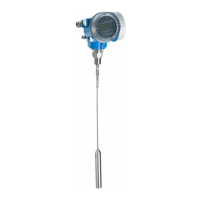Mounting Levelflex FMP56, FMP57 FOUNDATION Fieldbus
24 Endress+Hauser
6.1.3 Notes on the mechanical load of the probe
Tensile load limit of rope probes
Sensor Feature 060 Probe Tensile load limit [kN] Max. rupture load [kN]
1)
FMP56 LA, LB Rope 4mm (1/6") 316 12 20
NB, NE Rope 6mm (1/4") PA>Steel 12 20
FMP57 LA, LB Rope 4mm (1/6") 316 12 20
LC, LD Rope 6mm (1/4") 316 30 42
NB, NE Rope 6mm (1/4") PA>Steel 12 20
NC, NF Rope 8mm (1/3") PA>Steel 30 42
1) The ceiling of the silo must be designed to withstand this load.
Tensile load
Bulk solids exert tensile forces on rope probes whose height increases with:
• the length of the probe, i.e. max. cover
• the bulk density of the product,
• the silo diameter and
• the diameter of the probe rope
Since the tensile forces are also heavily dependent on the viscosity of the product, a higher
safety factor is necessary for highly viscous products and if there is a risk of cornice
buildup. In critical cases it is better to use a 6 mm rope instead of a 4 mm one.
The same forces also act on the silo cover. On a fixed rope, the tensile forces are definitely
greater, but this can not be calculated. Observe the tensile strength of the probes.
Options for reducing the tensile forces:
• Shorten the probe.
• If the maximum tensile load is exceeded, check whether it would be possible to use a
non-contact Ultrasonic or Level-Radar device.
The following diagrams show typical loads for frequently occurring bulk solids as reference
values. The calculation is performed for the following conditions:
• Calculation according to DIN 1055, Part 6 for the cylindrical part of the silo.
• Suspended probe (probe end not fixed at the bottom)
• Free-flowing bulk solid, i.e. mass flow. A calculation for core flow is not possible. In the
event of collapsing cornices, considerably higher loads can occur.
• The specification for tensile forces contains the safety factor 2 (in addition to the safety
factors already taken into account by DIN 1055), which compensates for the normal
fluctuation range in pourable bulk solids.

